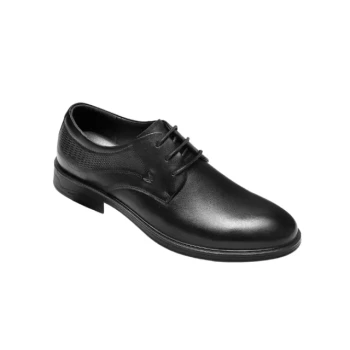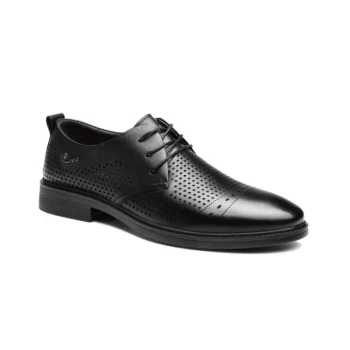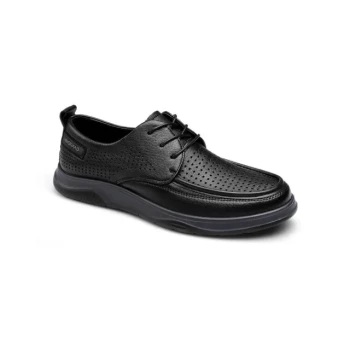Historically, men's formal shoes have been a powerful and immediate symbol of social status, wealth, and occupation. More than simple foot coverings, they were a clear marker separating the landed gentry from the working class and the office professional from the manual laborer. Their design evolution tells a story of social change, practicality, and shifting ideals of masculinity.
The significance of men's formal shoes lies in their journey from functional tools to deliberate signals of a man's place in society. Understanding their history reveals why specific styles, materials, and even lacing systems carry distinct connotations of formality to this day.
From Battlefield to Ballroom: The Origins of Status
The earliest forms of footwear were purely about function and protection. However, as societies stratified, shoes quickly became a key way to display one's standing, often by showcasing a deliberate lack of need for practicality.
The Heel as a Sign of Power
The heel was not invented for fashion. It was a practical tool for horsemen, helping to secure the rider's foot in the stirrups. Since owning horses was exclusive to the wealthy aristocracy, high heels became an immediate signifier of the non-laboring, land-owning class.
The Rise of Impractical Ornamentation
In the 17th and 18th centuries, European courts favored highly ornate shoes with elaborate buckles, bows, and expensive materials like silk. These delicate designs were a conspicuous display of wealth, broadcasting that the wearer did not need to walk on rough streets or perform any sort of manual labor.
The Birth of the Modern Dress Shoe
The 19th century brought a major shift known as the "Great Male Renunciation." Men's fashion moved away from aristocratic flamboyance toward the sober, tailored suits we recognize today. Shoes became a key canvas for signaling status through subtle, coded details rather than overt decoration.
The Oxford: A Rebellion in Formality
Originating as a comfortable alternative to restrictive boots for students at Oxford University, the Oxford shoe became the new standard for formality. Its defining feature—a "closed" lacing system where the shoelace eyelets are stitched underneath the vamp—creates a clean, sleek, and elegant silhouette.
The Derby: A Utilitarian Cousin
The Derby (or Blucher) has its roots in military wear. Its "open" lacing system, where the eyelet tabs are stitched on top of the vamp, allowed for a looser fit and made it easier to put on and take off. This practical origin story is why the Derby is still considered slightly less formal than the Oxford.
The Brogue: From Field to Firm
The decorative perforations on a Brogue shoe had a humble, practical beginning. They were holes punched into the leather to allow water to drain from the shoes of Irish and Scottish farmers working in wet bogs. Over time, this functional feature was adopted by the upper classes for country wear and eventually evolved into the decorative patterns we see today, a testament to how practical origins can transform into celebrated design.
The Enduring Signals and Trade-offs
The historical codes embedded in formal shoes still influence our perceptions today, often forcing a choice between traditional appearance and modern comfort.
The Signal of Cleanliness
A highly polished, well-maintained leather shoe historically signified an indoor, professional life, free from the dirt of manual labor. The ability to keep shoes clean was as much a status symbol as the shoe itself.
Craftsmanship as a Code
The method of construction, such as a Goodyear welt that allows a shoe to be resoled, speaks to a tradition of quality and longevity. This was historically a way to differentiate a gentleman's bespoke footwear from a commoner's mass-produced, disposable shoes.
The Formality vs. Function Dilemma
Modern athletic footwear is objectively more comfortable and versatile than a traditional leather-soled dress shoe. Choosing to wear a formal shoe is often a conscious decision to prioritize tradition, aesthetic, and social code over pure functional comfort.
How to Apply This to Your Wardrobe
Understanding this history allows you to make more intentional choices about what your footwear communicates.
- If your primary focus is maximum formality (black tie, conservative business): The clean, unadorned black Oxford is the direct descendant of the shift toward sober elegance and remains the undisputed standard.
- If your primary focus is business versatility: The Derby offers a professional look with a slightly more accommodating fit, reflecting its practical, robust heritage.
- If your primary focus is expressing personality within formal codes: The Brogue uses its historical, decorative perforations to add visual interest without sacrificing the structure of a classic dress shoe.
Ultimately, your choice in formal footwear is a deliberate act of communication, rooted in centuries of social and cultural history.
Summary Table:
| Style | Historical Origin | Key Characteristic | Modern Use Case |
|---|---|---|---|
| Oxford | 19th-century student rebellion | Closed lacing system | Maximum formality, black tie events |
| Derby | Military/practical wear | Open lacing system | Business versatility, accommodating fit |
| Brogue | Functional drainage for farmers | Decorative perforations | Expressing personality within formal codes |
Ready to command attention with historically significant footwear?
As a large-scale manufacturer, 3515 produces a comprehensive range of footwear for distributors, brand owners, and bulk clients. Our production capabilities encompass all types of shoes and boots, including premium formal styles rooted in the rich history detailed above. We can help you build a collection that communicates quality and tradition.
Contact our team today to discuss your manufacturing needs and discover the 3515 advantage.
Related Products
- Wholesale Leather Derby Dress Shoes Custom Manufacturer for Brands
- Factory Direct Wholesale Leather Comfort Shoes with Dial Closure
- Custom Manufactured Air Cushion Leather Business Shoes for Wholesale
- Wholesale Leather Business Casual Shoes with Dial Closure - Manufacturer of Comfort Dress Sneakers
- Wholesale Comfortable Business Casual Shoes Custom Manufacturing
People Also Ask
- What are the main types of dress shoes with laces? A Guide to Oxfords, Derbys & More
- What is the main difference between Derby Shoes and Oxford Shoes? It's All in the Lacing.
- What should consumers look for to avoid misleading claims about leather quality? A Guide to Identifying Genuine Quality
- What are the key features of high-quality leather in shoes? Invest in Durability and a Perfect Fit
- What are the key styles of men's dress shoes? Build a Timeless & Versatile Shoe Collection



















